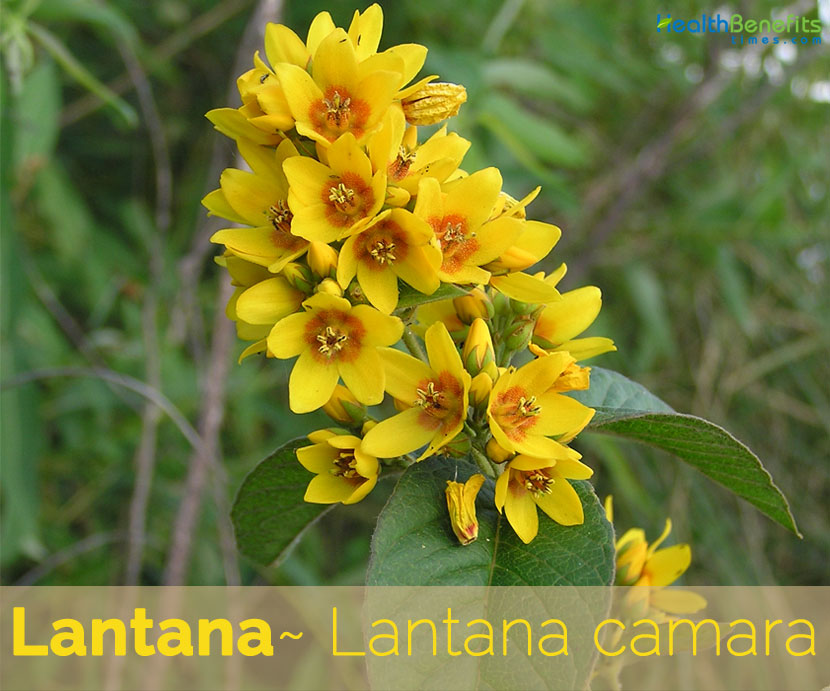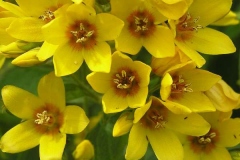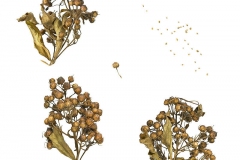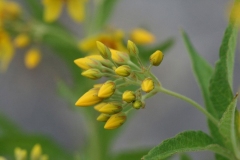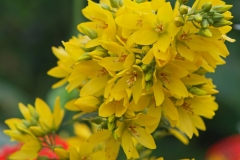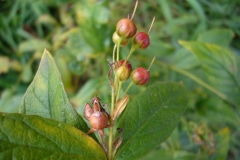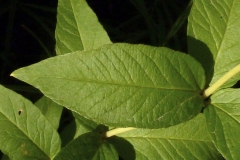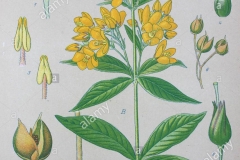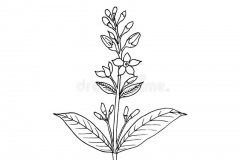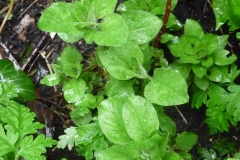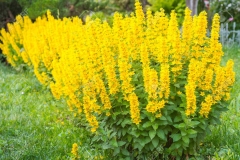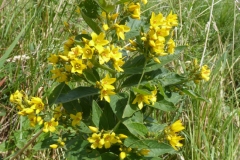| Yellow Loosestrife Quick Facts | |
|---|---|
| Name: | Yellow Loosestrife |
| Scientific Name: | Lysimachia vulgaris |
| Origin | Europe and North Asia but was introduced to North America in the 1900s for decorative purposes |
| Shapes | Egg shaped seed capsules that contain a few seeds and split open when ripe |
| Taste | Astringent and slightly acrid |
| Health benefits | Beneficial for diarrhea, dysentery, hemorrhages, sore gums, mouth ulcers, canker sores, tender gums and menstrual flow |
| Name | Yellow Loosestrife |
|---|---|
| Scientific Name | Lysimachia vulgaris |
| Native | Europe and North Asia but was introduced to North America in the 1900s for decorative purposes |
| Common Names | Loosestrife, yellow willowherb, wood pimpernel, garden loosestrife, Garden yellow loosestrife, Loosestrife, Willow-weed, Willowwort, Yellow loosestrife, Golden loosestrife, Willow-wort, Herb Willow, Garden Yellow-Loosestrife, gele wederik |
| Name in Other Languages | Afrikaans: Tuin loosestrife Albanian: Loosestrife kopsht, lisimaka e zakonshme, lisimake Amharic: Ye’ātikiliti loosestrife (የአትክልት loosestrife) Arabic: Nahlal hdyqt (انحلال حديق), ainhilal hadiqa Armenian: Partezi k’vogharkich (պարտեզի քողարկիչ) Azerbaijani: Bağ boşluğu, Adi qoyunboğan Belarusian: Lazanica zvyčajnaja (Лазанiца звычайная) Bengali: Bāgāna ālagā (বাগান আলগা) Bulgarian: Gradinski lozerif (градински лозериф), obiknoveno lenivche (обикновено ленивче) Burmese: U yyaarin loosestrife (ဥယျာဉ် loosestrife) Catalan: Lisimàquia vulgar, Lisimàquia Chinese: Huāyuán zhēnzhū cài (花园珍珠菜), Huánglián huā (黄连花), Máo huánglián huā (毛黄连花) Croatian: Vrtni gubitak Czech: Zahradní loosestrife, vrbina obecná Danish: Have loosestrife, Almindelig fredløs, Almindelig Fredløa Dutch: Tuin kattestaart, Grote wederik, gele wederik, English: garden loosestrife, Garden yellow loosestrife, Loosestrife, Willow-weed, Willowwort, Yellow loosestrife, Golden loosestrife, Willow-wort, Herb Willow, Garden Yellow-Loosestrife, gele wederik, Esperanto: Gardeno loosestrife Estonian: Aed loosestrife, Harilik metsvits, Metsvits Filipino: Hardin loosestrife Finnish: Puutarha irtonainen, Ranta-alpi French: Salicaire du jardin, Lysimaque commune, Chasse-bosses, Herbe aux corneilles, Lysimaque vulgaire, Grande lysimaque, casse-bosse, chasse-querelle des Anglais, Corneille, lis des teinturiers, perce-bosse, pêcher des prés, souci d’eau Georgian: Baghi loosestrife (ბაღი loosestrife) German: Garten Loosestrife, Gewöhnlicher Gilbweiderich, Gewöhnlicher Felberich, Rispen-Gilbweiderich, Gemeiner Felberich, Gemeiner Gilbweiderich, großer gelber Weiderich Greek: Chalárosi kípou (χαλάρωση κήπου), koiní lysimachía (κοινή λυσιμαχία) Gujarati: Bagīcō chūṭaka (બગીચો છૂટક) Hausa: Lambun loosestrife Hebrew: גן משוחרר Hindi: Baag shithilata (बाग़ शिथिलता) Hungarian: Kerti loosestrife, Közönséges lizinka, mocsári lizinka Icelandic: Garður loosestrife Indonesian: Taman loosestrife Irish: Loosestrife gairdín, Breallán léana Italian: Loosestrife da giardino, Mazza d’oro comune, lisimachia commune, mazza d’oro Japanese: Gāden okatoranoo (ガーデンオカトラノオ), Kusaredama (クサレダマ) Javanese: Loosestrife kebon Kannada: Udyāna saḍilagoḷisuvike (ಉದ್ಯಾನ ಸಡಿಲಗೊಳಿಸುವಿಕೆ) Kazakh: Baqşa bos (бақша бос) Korean: Jeong-won neuseunhan (정원 느슨한) Kurdish: Loosestrife baxçe Lao: Loosestrife suan (loosestrife ສວນ) Latin: Hortus loosestrife Latvian: Dārza birste, parastā zeltene Lithuanian: Sodo palaidinukė, Paprastoji šilingė Lower Sorbian: Žołty wjerbnik Macedonian: Gradina loosestrife (градина loosestrife) Malagasy: Loosestrife zaridaina Malay: Loosestrife taman Malayalam: Pūntēāṭṭaṁ ayaññava (പൂന്തോട്ടം അയഞ്ഞവ), lisimaciya valgāris (ലിസിമചിയ വൽഗാരിസ്) Maltese: Loosestrife tal-ġnien Marathi: Baag sail (बाग सैल) Mongolian: Tsetserlegiin sulral (цэцэрлэгийн сулрал) Northern Sami: Gáddečuovgi Nepali: Bagaicā ḍhilō (बगैचा ढिलो) Norwegian: Garden loosestrife, Fredlaus, Fredløs Occitan: Bastoun de st jóusè Oriya: ବଗିଚା Pashto: د باغ Persian: loosestrife باغ, علف بیدی Polish: Luźny ogród, Tojeść pospolita, tojeść zwyczajna Portuguese: Jardim loosestrife, arnestre, erva-coelheira, erva-moedeira, grande-lisimáquia, lisimáquia, lisimáquia-vulgar, Punjabi: Bāga looseilī (ਬਾਗ looseਿੱਲੀ) Romanian: Grădină loosestrife Russian: Sadovyy verbeynik (садовый вербейник), Verbeynik obyknovennyy (Вербейник обыкновенный) Serbian: baštenski lopovi (баштенски лопови), obični protivak (обични противак), trava od metilja (трава од метиља) Sindhi: باغ لوز ڪرڻ Sinhala: Vatta lihil kirīma (වත්ත ලිහිල් කිරීම) Slovak: Cerkáč obyčajný Slovenian: Vrtna vrba, navadna pijavčnica Spanish: Lisimaquia de jardín, Navadna pijavčnica, hierba de la sangre, hierba de las acequias, lisimaquia amarilla, lisimaquia vulgar, lisimaquia áurea, lisimaquia, Lismaquia, hierba de las cequias, lisimaquia Sudanese: Kebon loosestrife Swedish: Trädgård loosestrife, Ranta-alpi, Strandlysing, Videört, Vanlig lysing Tajik: ʙoƣi loosestrife (боғи loosestrife) Tamil: Tōṭṭam taḷarttal (தோட்டம் தளர்த்தல்) Telugu: Tōṭa vadulu (తోట వదులు) Thai: S̄wn loosestrife (สวน loosestrife) Turkish: Bahçe loosestrife, kargaotu Ukrainian: -sadovyy vinochok (садовий віночок), Verbozillya zvychayne (Вербозілля звичайне) Upper Sorbian: Wysoka žołtnica Urdu: باغ ڈھیلا Uzbek: Bog ‘loosestrife Vietnamese: Vườn lỏng lẻo Welsh: Loosestrife gardd, Trewyn Zulu: Ingadi evundile |
| Plant Growth Habit | Attractive, tall, herbaceous perennial flowering plants |
| Growing Climates | Marshes, streams, shallow water in reed swamps, shady places near water, fens, wet woods, lake shores, and river banks, freshwater wetlands, beaches, wet meadows, floodplain forests, roadside embankments, herbaceous wetland, salt marsh, yard or garden, riparian zones |
| Soil | Plants thrive well in damp or soaked loamy (clay) soil. Although the plant has a preference for shady locales, it succeeds in sun as well as partly shaded positions. Clay soils are most appropriate for the robust growth of yellow loosestrife |
| Plant Size | From 50 -150 cm tall (1.5-5 feet) |
| Root | Creeping root, which persists year after year |
| Stem | Erect, terete or obtusely quadrangular, simple or paniculately branched, pubescent and covered with a soft, fine down |
| Leaf | Leaves are 3‐5 inches long, ovate, hairy beneath, and irregularly arranged (usually in whorls of 3‐4, sometimes opposite) , with small orange or black glands on the underside visible with magnification |
| Flowering season | April to September |
| Flower | Flowers are yellow, showy and primrose‐like (5 petals), with the biggest cluster atop the stem and smaller clusters on stalks from the base of the upper leaves. Stamens are red‐ orange |
| Fruit Shape & Size | Egg shaped seed capsules that contain a few seeds and split open when ripe |
| Propagation | By its seed, basal cuttings, root cuttings as well as root division |
| Flavor/Aroma | No odor |
| Taste | Astringent and slightly acrid |
| Plant Parts Used | Whole aerial parts |
Plant Description
Yellow Loosestrife is attractive, tall, herbaceous perennial flowering plants that normally grows from 50 -150 cm tall (1.5-5 feet) and has a creeping rhizome with numerous runners (stolons) that produce branched erect stems. The plant is found growing in marshes, streams, shallow water in reed swamps, shady places near water, fens, wet woods, lake shores, river banks, freshwater wetlands, beaches, wet meadows, floodplain forests, roadside embankments, herbaceous wetland, salt marsh, yard or garden and riparian zones. The plant thrives well in damp or soaked loamy (clay) soil. Although the plant has a preference for shady locales, it succeeds in sun as well as partly shaded positions. Clay soils are most appropriate for the robust growth of yellow loosestrife. The plant has creeping root, which persists year after year. Stems are erect, terete or obtusely quadrangular, simple or paniculately branched, pubescent and covered with a soft, fine down.
Leaves
Plant bears number of nearly stalk less leaves, sometimes in pairs, sometimes three or four springing from the same spot. They are rather large and broad, 3 to 6 inches (7-12 cm) long and about 1 1/4 inches (1.5-4 cm) broad, oblong or lance-shaped and sharply tapering at the top. Their edges are unbroken. The undersurfaces are downy with soft, spreading hairs, especially on the veins, and the upper surfaces are marked with black dots which are glands. Whatever arrangement we find in any given plant holds throughout: we do not find in the same plant some of the leaves in pairs and others in three. When the leaves are in pairs, the stem is quadrangular and the angles increase as the leaves increase in number. The middle and upper leaves have short petioles and are acuminate.
Flower
At the top of the stem arise the flower-buds, in the axils of the leaves. Each becomes a short stalk carrying a terminal flower, below which other flowers on smaller stalks arise – the ends of the main stem thus becoming covered with a mass of golden blossoms. The flower stalks are slightly viscid, or sticky, to the touch. Each flower is about 3/4 inch in diameter, forming a cup of five petals, quite distinct at their tips, but joined together near the base. When the flowers droop, the five-pointed calyx, whose edges are fringed with fine red hairs is seen at the back of the petals. The five stamens look quite separate, but are joined together at the bottom by a fleshy band attached to the petals, so that they seem to stand on a little glandular tube. Flowering normally takes place in between April to September.
Fruits
Fertile flower are followed by egg shaped seed capsules that contain a few seeds and split open when ripe. The seeds of this plant are most likely water-dispersed. However, the main method of dispersal for this plant is via rhizomes.
Traditional uses and benefits of Yellow Loosestrife
- An astringent herb, yellow loosestrife is principally used to treat gastro-intestinal conditions such as diarrhea and dysentery.
- The herb is astringent, demulcent and expectorant.
- Plant can be used internally or externally and is useful in checking bleeding of the mouth, nose and wounds, restraining profuse hemorrhages of any kind and in the treatment of diarrhea.
- It makes a serviceable mouthwash for treating sore gums and mouth ulcers.
- Loosestrife proves useful in checking bleeding of the mouth, nose and wounds, restraining profuse hemorrhage of any kind.
- It can be used to clean minor wounds, cuts, and scrapes and halt nosebleeds and another minor bleeding, both externally and internally.
- In the form of mouthwashes, a tea made from the herb can be used as an herbal remedy for mouth ulcers (canker sores) and bleeding or inflamed gums.
- It is regarded to be useful as a relief for sore eyes and is thought to be of equivalent or maybe greater value than eyebright (Euphrasia officinalis).
- Herb is also helpful as a mouthwash, especially to heal canker sores and tender gums.
- It is effective in restricting any type of hemorrhages.
- Yellow loosestrife can also be used as an effective mouthwash for curing ulcers in the mouth.
- Yellow loosestrife is used as a remedy for profuse menstrual flow and hemorrhage.
Other Facts
- Yellow dye is obtained from the flowers.
- Brown dye is obtained from the rhizomes.
- The growing plant repels gnats and flies; it has been burnt in houses in order to remove these insects.
- Rhizome and the runners give a brown color, while the leaves and stems give a yellow color.
- Smoke exuded by the burning yellow loosestrife is used by people to keep off snakes.
- Yellow Loosestrife tied around the necks of oxen was reputed to keep irritating flies away from them.
- In the distant past these and several other kinds of ‘loosestrife’ plants were also used to get rid of infestations of flies in houses.
- The plants were dried and burned indoors, and toxins in the smoke drove out the flies (and no doubt also any human occupants).
Different Control Methods
Biological
There are no known biological control agents for this species.
Physical
Hand-pulling is effective for small infestations and/or for young plants. Care should be taken to dig out and remove all plant fragments, particularly the rhizomes, to prevent regrowth. All seed heads and rhizomes pieces should be disposed of in plastic bags and removed from the site.
Repeated mowing of L. vulgaris may contain the existing population, but it will not eradicate it.
Chemical
To control larger infestations, treatment with herbicides containing glyphosate, imazapyr, or triclopyr may be necessary. It is important to note that glyphosate and imazapyr are non-selective and will harm any plant it comes in contact with. Tricolpyr will not harm grasses, sedges, or cattails, and may be more appropriate to use in diverse plant communities.
Physical control methods should not be used on populations treated with herbicides until several weeks after application.
Precautions
- If used for prolonged periods, tannins contained in the plant may cause deficiency of essential minerals within the body.
- It should not be used for internal medicinal purposes for prolonged periods.
References:
https://www.itis.gov/servlet/SingleRpt/SingleRpt?search_topic=TSN&search_value=24002#null
https://pfaf.org/user/Plant.aspx?LatinName=Lysimachia+vulgaris
https://www.cabi.org/isc/datasheet/115436
http://www.missouribotanicalgarden.org/PlantFinder/PlantFinderDetails.aspx?taxonid=285534
http://www.floracatalana.net/lysimachia-vulgaris-l-
https://www.botanical.com/botanical/mgmh/l/looyel41.html
https://plants.usda.gov/core/profile?symbol=LYVU
http://www.theplantlist.org/tpl1.1/record/kew-2492070
https://www.invasiveplantatlas.org/subject.html?sub=5983
https://nas.er.usgs.gov/queries/GreatLakes/FactSheet.aspx?SpeciesID=254
https://gd.eppo.int/taxon/LYSVU
https://davesgarden.com/guides/pf/go/1126/#b


